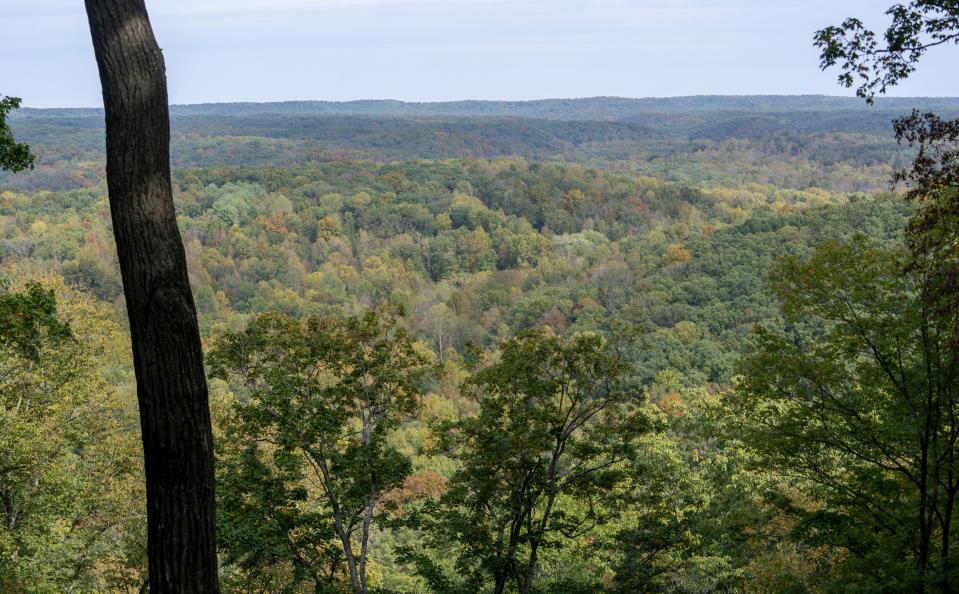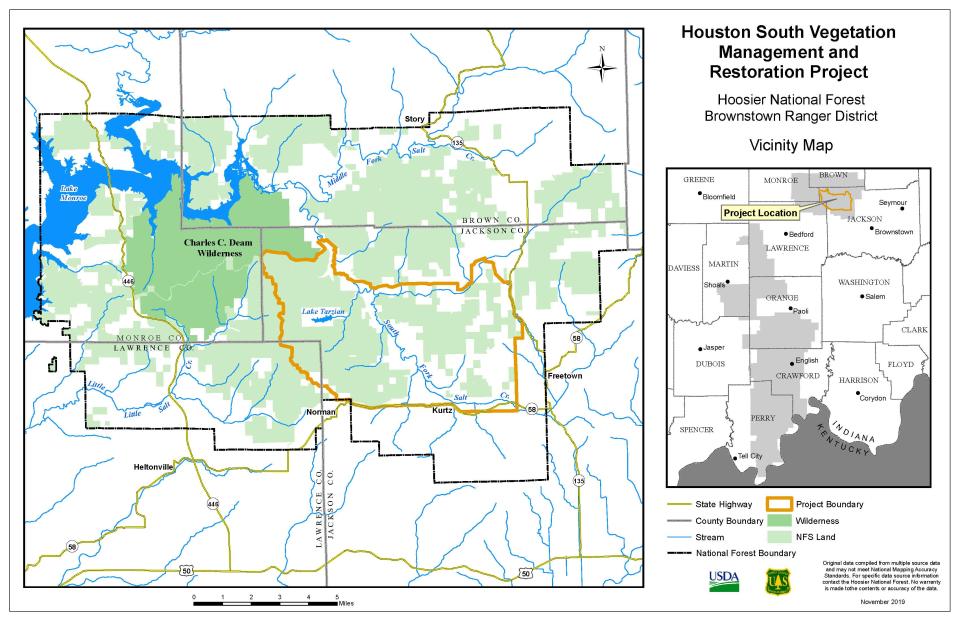Would Hoosier National Forest project endanger a key Southern Indiana drinking water source?
A new U.S. Forest Service assessment of its plans to manage part of the Hoosier National Forest with logging and controlled burns was intended to clear confusion about the impact on Lake Monroe, but critics of the controversial project say the report is still lacking.
The assessment comes on the heels of two lawsuits over the Houston South management project.
Chris Thornton, district ranger for the Hoosier National Forest said Friday the assessment “clarifies the demonstrated effectiveness of erosion control measures for projects like Houston South and shows that following our standards and guidelines, reduces sedimentation and would not affect the water quality of Monroe Lake.”

But Jeff Stant, executive director of the Indiana Forest Alliance, said the newest USFS report is a rehashing of previous reports and fails to provide new and specific data that would show the project will not have a negative impact on the important regional water source.
“They are not addressing the concerns that scientists, and environmental advocates citing the work of scientists, are raising,” Stant told IndyStar. "That's just infuriating. It just does not comply with the requirements for them to genuinely address the environmental effects and that means they have to take the public’s input seriously."
Thornton said the agency values public comments.
“I read every one of them because I think it’s important and that’s part of my job is to understand fully what the public wants,” Thornton said.
The new back-and-forth is the latest skirmish in a long-simmering fight over the forest service's Houston South Vegetation Management and Restoration Project, which covers the northwestern portion of Jackson County and a small northeast corner of Lawrence County. The project would allow the agency to harvest trees and perform prescribed burns over a 10–15-year period as part of a plan to rejuvenate parts of the Hoosier National Forest.
The area contains mature forest, but little in terms of early forest growth. The plan is to harvest about 4,300 acres of pine and hardwood trees, implement prescribed burns on 13,500 acres. The agency plans to take other measure to promote forest health and enable more young growth, particularly hardwoods that serve as hosts to hundreds of native species. In addition, the agency plans to repair and relocate some roads and trails and as fix areas where erosion has occurred to reduce the amount of sediment entering nearby waterways.
The overarching goal of the project, Thornton said, is to improved the sustainability of the forest.
“We've heard from those favoring a hands-off approach to those who'd like more extensive management actions and everyone in between,” Thornton said. “No matter what your stance, the long-term stewardship of the Hoosier National Forest will require that compromises be made for a healthy, functioning ecosystem 100-plus years down the road.”
Several groups have filed two lawsuits in previous years against the service, claiming the project would hurt the water quality of Lake Monroe.
The first lawsuit opposing the USFS plan was filed in 2022 with the goal of halting the Houston South project. A judge dismissed the suit, but that action is being appealed in the 7th Circuit Court of Appeals.
The second suit was filed in January by the Monroe County Board of Commissioners, Indiana Forest Alliance, Hoosier Environmental Council and Friends of Lake Monroe. It ultimately delayed the USFS plan until the agency could provide evidence that its forest management practices would not deteriorate Lake Monroe’s water quality.
The service’s new report released Friday comes after a U.S. District Court ruling in March 2022 that found the service violated the National Environmental Policy Act by “failing to fully evaluate the environmental effects to Lake Monroe,” and a U.S. Fish and Wildlife Service finding that put the northern long-eared bat on the federally endangered list.
A core part of the agency’s mission is to protect water quality, Thornton said, and the USFS would not consider proposing any project they had a reason to believe would endanger a source of drinking water.
Protecting water quality at Lake Monroe
Lake Monroe, the largest lake entirely within the state, is the sole source of drinking water for more than 130,000 people in nearby areas. The lake's water quality already is considered impaired, according to the Indiana Department of Environmental Management.
Last year, IDEM published data showing the lake’s public drinking water parameters exceeded algae levels while mercury and industrial chemicals were found in fish.
A management plan put together in 2022 by Friends of Lake Monroe found that fertilizer, animal manure, sediment and pollution from septic system leaks are washed into the lake when it rains.

Sediment is only one contributing pollutant to the lake and is carried into the water from surrounding streams. That erosion needs to be reduced, the report says, because more than half of Lake Monroe’s watershed is highly susceptible to erosion.
Sherry Mitchell-Bruker, founder and president of Friends for Lake Monroe and former watershed manager at Lassen National Forest, supported the legal challenge against the Houston South project.
In court documents filed in March, Mitchel-Bruker said she does not believe the Hoosier National Forest has provided enough evidence to protect Lake Monroe's water quality by way of using best management practices.
"Indeed, this Forest’s past history demonstrates that it does not view (best management practice) implementation, monitoring, or documentation as a serious matter worthy of the agency’s attention," Mitchell-Bruker said.
Houston South lawsuit: Court injunction stops planned controlled burns in Hoosier National Forest
The future of the Houston South management plan
The public has a 30-day period to submit written comments on the forest service’s latest environmental assessment.
Thornton said the service will look at comments for any changes that need to be made and will then issue a final environmental assessment. If no big issues are found, USFS will produce a draft Finding of No Significant Impact, which will open a new 45-day objection period.
Comments on this new draft environmental assessment can be sent to Christopher Thornton via:
Mail: 811 Constitution Ave., Bedford, IN, 47421
Fax: 812-279-3424
Email: comments-eastern-hoosier@usda.gov with subject line, Houston South Vegetation Management and Restoration Project Supplement
Karl Schneider is an IndyStar environment reporter. You can reach him at karl.schneider@indystar.com. Follow him on Twitter @karlstartswithk
IndyStar's environmental reporting project is made possible through the generous support of the nonprofit Nina Mason Pulliam Charitable Trust.
This article originally appeared on Indianapolis Star: New report outlines protections for Lake Monroe during forest project

